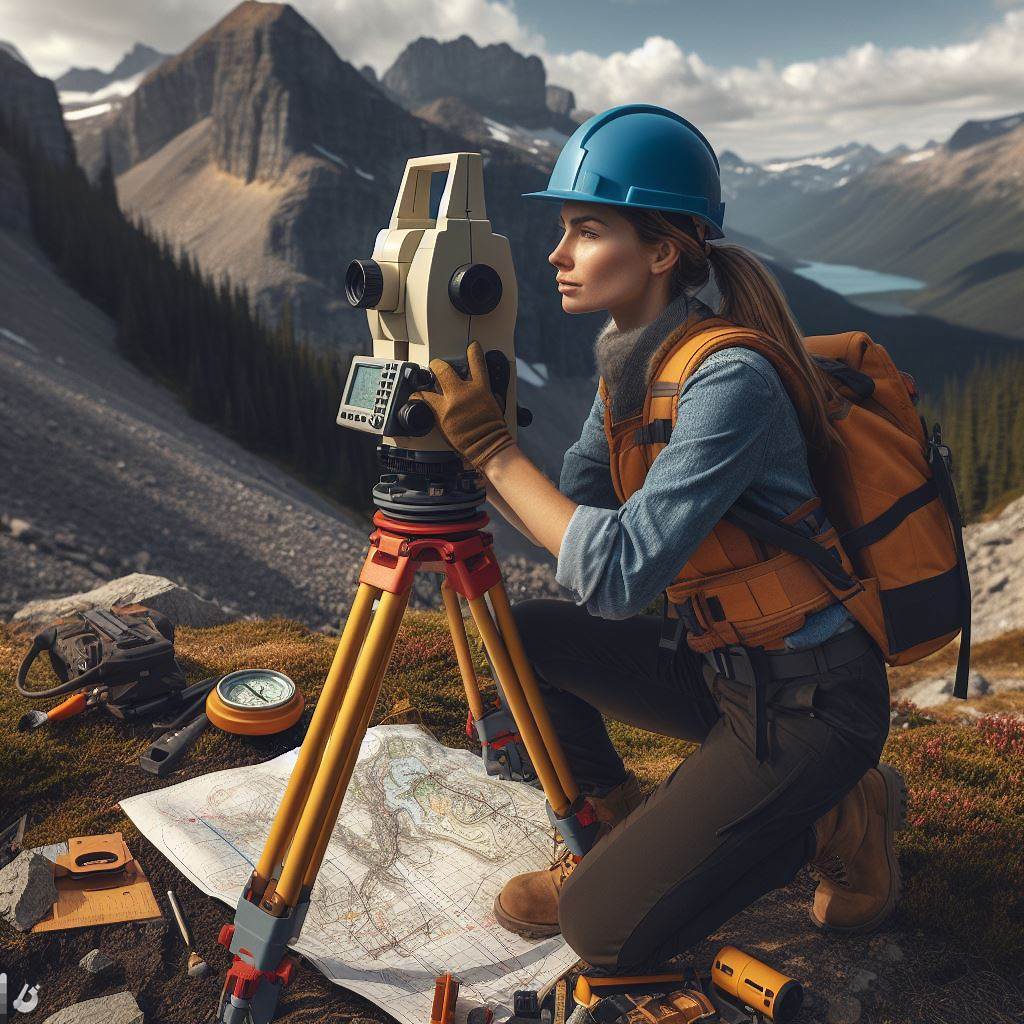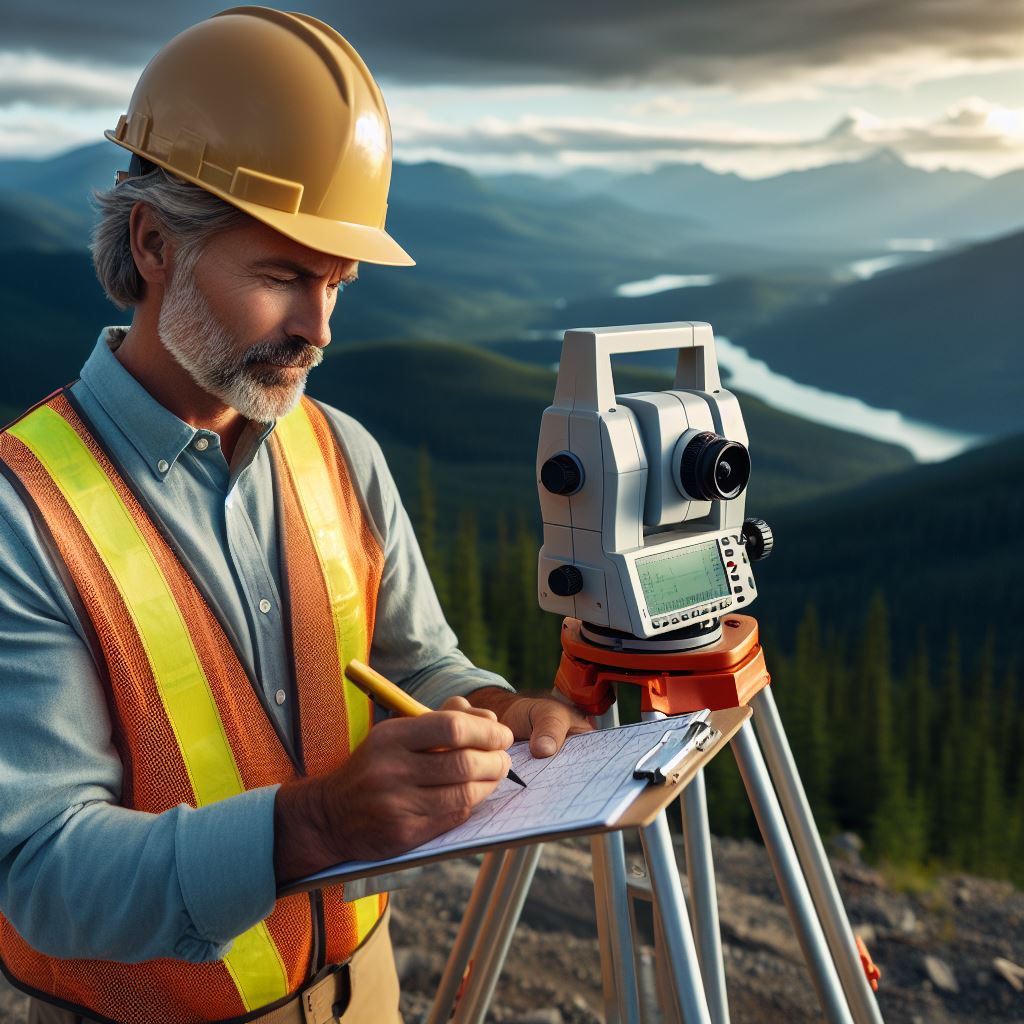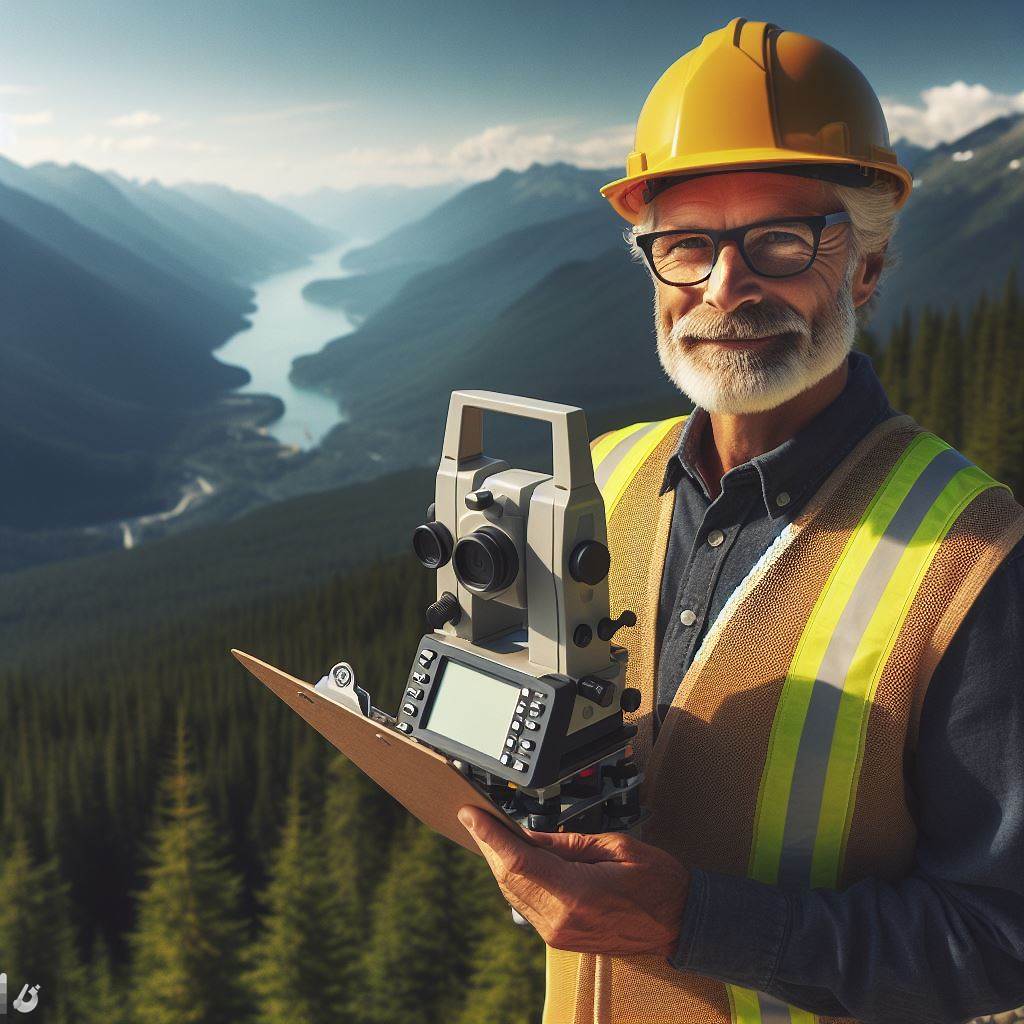Introduction
Land surveying has played a crucial role in shaping Canada’s development and growth over the years.
Surveying land accurately has been essential in determining property boundaries and resolving disputes.
This post will explore key historical periods and events that have impacted land surveying in Canada.
Journey beyond mere maps and coordinates, as we unravel the nuanced layers of “The History of Land Surveying in Canada.”
This expedition spans epochs, capturing the resilience and innovation of surveyors who navigated rugged wilderness, inclement weather, and diverse cultures to meticulously measure and define the vast expanse of Canada’s landscapes.
Immerse yourself in the narratives of early surveying expeditions, where theodolites and compasses were wielded like tools of discovery.
Witness the evolution of surveying methodologies, from classical techniques to cutting-edge technologies, and explore the legal frameworks that arose to regulate land ownership.
This exploration promises a vivid tapestry of Canadian history, blending tales of exploration, technological advancement, and the enduring legacy of those who etched the surveyor’s mark on the very fabric of the nation.
Join us in this odyssey through time, where each measured step unveils a section in the captivating story of Canada’s geographical metamorphosis..
Early Beginnings
The history of land surveying in Canada begins long before European colonization, with Indigenous peoples playing a significant role in this field.
Prior to European arrival, Indigenous communities had their own techniques and methods for measuring and demarcating land.
The role of Indigenous peoples in land surveying prior to European colonization
Indigenous peoples had a deep understanding of the land and its resources.
They recognized the importance of accurately assessing boundaries and territories for the sustainable use of natural resources.
This knowledge was crucial for their survival and the well-being of their communities.
The techniques and methods used by Indigenous communities for measuring and demarcating land
Walking survey
One of the techniques used by Indigenous communities for measuring land was the “walking survey.”
This method involved walking the perimeter of the land, using natural landmarks such as rocks, trees, and rivers as reference points.
The surveyors would memorize the boundaries in great detail and pass this knowledge down through generations.
Medicine wheels
Another method employed by Indigenous communities was the use of “medicine wheels.”
These circular stone structures served as ceremonial sites, but also acted as surveying tools.
The wheels were positioned on the land in relation to significant celestial events, allowing for various measurements and alignments.
Octagonal method
Indigenous peoples also utilized surveying techniques involving geometric patterns.
For example, the Cree Nation used the “octagonal method,” which involved constructing octagonal structures to establish land boundaries.
These structures were typically made of wood or other materials and placed at strategic locations to mark off the land.
The arrival of European colonizers brought significant changes to the land surveying practices in Canada.
The Europeans introduced their own measurement systems, such as the British system of chains and links.
Unlock Your Career Potential
Visualize a clear path to success with our tailored Career Consulting service. Personalized insights in just 1-3 days.
Get StartedThey also established a hierarchical system of land ownership and implemented land surveys to allocate land to settlers.
Despite these changes, Indigenous knowledge and practices continued to play a role in land surveying.
European surveyors often relied on Indigenous guides and interpreters who possessed intricate knowledge of the land.
This collaboration between Indigenous communities and European surveyors was crucial in accurately mapping vast territories.
However, it is important to acknowledge that European colonization had detrimental consequences for Indigenous peoples in Canada.
The imposition of European land surveying practices resulted in the displacement and dispossession of many Indigenous communities from their ancestral lands.
Today, there is a growing recognition of the importance of incorporating Indigenous perspectives and practices into land surveying in Canada.
Efforts are being made to promote Indigenous-led land surveys and to acknowledge the ongoing connections that Indigenous peoples have with their traditional territories.
In fact, the history of land surveying in Canada has deep roots in Indigenous knowledge and practices.
The techniques and methods, rooted in a deep understanding of the land, continue to shape land surveying practices today.
However, it is crucial to acknowledge the negative impacts of colonialism and work towards a more inclusive and respectful approach to land surveying in Canada.
Read: Surveying and the Environment: A Canadian Focus
European Colonization and the Royal Proclamation of 1763
The impact of European colonization on land surveying practices in Canada
The impact of European colonization on land surveying practices in Canada was significant.
European settlers arrived in Canada and sought to establish permanent settlements, leading to the need for systematic land surveying and ownership records.
The introduction of the Royal Proclamation of 1763 and its significance in establishing land ownership and surveying standards
The Royal Proclamation of 1763 was a crucial development in establishing land ownership and surveying standards in Canada.
This proclamation, issued by King George III, aimed to regulate the colonization of North America and prevent conflicts with indigenous peoples.
One of the key aspects of the Royal Proclamation was the recognition of indigenous land rights.
The proclamation recognized the rights of indigenous peoples to their traditional lands and prohibited the unauthorized purchase or settlement of indigenous territories.
This recognition of indigenous land rights had a direct impact on land surveying practices.
It meant that surveys had to be conducted to determine the boundaries of indigenous territories and to ensure that settlers did not encroach upon these lands.
The Royal Proclamation also established a system for the surveying and granting of land to European settlers.
It set out specific instructions for the surveying of land, including the use of standardized measurement units and the establishment of boundary lines.
Surveyors were appointed by the British government to undertake the task of mapping out and surveying the newly acquired lands.
These surveyors were responsible for measuring and marking the boundaries of the land to be granted to settlers.
Its significance in establishing land ownership and surveying standards
Land surveying became a crucial component of colonial administration in Canada.
It enabled the orderly distribution of land to settlers and helped to resolve disputes over land ownership and boundaries.
The Royal Proclamation also established the framework for future land surveying practices in Canada.
It provided the basis for the division of land into townships and ranges, which became the standard method for surveying and organizing land in Canada.
The surveying practices introduced by the Royal Proclamation formed the foundation for the modern land surveying system in Canada.
The use of standardized measurement units and boundary lines helped to establish clear and consistent land ownership records.
Overall, European colonization and the Royal Proclamation of 1763 had a profound impact on land surveying practices in Canada.
They led to the development of a systematic and organized approach to land surveying, which continues to be an essential part of Canadian land administration today.
Read: Indigenous Land Surveys in Canada: Unique Aspects
The Dominion Land Survey
During the late 19th century, the Dominion Land Survey system was implemented in Western Canada.
This surveying system played a crucial role in shaping the land division and settlement of the region.
Overview of the Dominion Land Survey System
- The Dominion Land Survey (DLS) aimed to accurately measure and divide the territory of Western Canada.
- The system was initiated in 1869 by the federal government to promote orderly settlement.
- It covered vast areas of Manitoba, Saskatchewan, Alberta, and parts of British Columbia.
- Under the DLS, land was divided into six-mile by six-mile squares called townships.
- Each township was then further divided into 36 one-mile by one-mile sections.
Goals and Objectives of the Dominion Land Survey
- The primary goal of the Dominion Land Survey was to facilitate land ownership and land administration.
- The system aimed to establish a consistent and reliable method for land distribution.
- It sought to encourage agricultural settlement and economic development in Western Canada.
- The DLS also aimed to establish a grid system that would guide future infrastructure development.
Methodology and Tools Used in the Surveying Process
- The surveyors utilized various tools and techniques to accurately measure and demarcate the land.
- The surveying process began with the establishment of a baseline.
- The baseline was a precisely measured line running east to west, serving as a reference for further measurements.
- Surveyors used chains, compasses, and theodolites for accurate measurements and angular calculations.
- They also used astronomical observations to determine latitude and longitude.
- Surveyors meticulously recorded their measurements and calculations in field notebooks.
- The data collected during the survey was then used to create detailed maps and legal descriptions of the land.
The Dominion Land Survey system played a significant role in the development and settlement of Western Canada.
It provided a standardized method for land division and ownership, allowing for efficient settlement and economic growth.
The accurately measured townships and sections facilitated orderly land administration and infrastructure development in the region.
The DLS became an essential tool in guiding future land use and urban planning.
By implementing the Dominion Land Survey, the Canadian government ensured fair and equitable land distribution, promoting a sense of stability and permanence for settlers in Western Canada.
Today, the legacy of the Dominion Land Survey can still be observed in the grid-like patterns of cities and towns across Western Canada, serving as a reminder of the important historical role played by land surveying in shaping the nation.
Read: Women in Surveying: Changing Trends in Canada

The National Topographic System
The establishment of the National Topographic System (NTS) in the 20th century marked a significant milestone in land surveying in Canada.
Establishment of the National Topographic System
The NTS was established in the 20th century with the aim of creating detailed and accurate maps of Canada’s vast and diverse landscape.
The system involved a collaborative effort between various government departments, including Natural Resources Canada and the Canadian Armed Forces.
Highly skilled surveyors used advanced tools and techniques to collect data on the physical features of the land.
This data was then used to create topographic maps that depicted the elevation, terrain, and other important details of the Canadian landscape.
Aerial Photography and Modern Mapping Techniques
Aerial photography played a crucial role in revolutionizing land surveying in Canada.
By taking photographs from above, surveyors were able to capture detailed images of the land, improving the accuracy and efficiency of their work.
The introduction of modern mapping techniques, such as photogrammetry and remote sensing, further enhanced the capabilities of the NTS.
These techniques allowed surveyors to collect data more quickly and accurately, resulting in more detailed and up-to-date maps.
Benefits and Applications of the National Topographic System
The National Topographic System has had numerous benefits and applications in various industries across Canada.
In the field of resource exploration, the NTS maps have helped identify potential areas for mining, oil, and gas exploration.
Forestry companies have utilized the detailed maps to plan timber harvesting activities and manage forest resources sustainably.
Emergency services, such as search and rescue teams, rely on the NTS maps to navigate and locate individuals in remote areas.
Transportation and logistics industries use the maps to plan routes, determine road conditions, and calculate distances between locations.
Furthermore, the NTS maps are invaluable for outdoor enthusiasts and adventurers, offering detailed information on hiking trails, campsites, and recreational areas.
The NTS Today
The National Topographic System continues to play a vital role in land surveying and mapping in Canada.
Advancements in technology have allowed for even greater accuracy and accessibility of the NTS data.
Today, digital maps and geographic information systems (GIS) provide users with interactive and customizable mapping tools.
These tools offer a range of features, such as the ability to measure distances, overlay different layers of information, and conduct geospatial analysis.
With ongoing updates and improvements, the NTS remains a critical resource for professionals and individuals alike.
In general, the establishment of the National Topographic System and the use of aerial photography and modern mapping techniques have transformed land surveying in Canada.
The NTS has revolutionized various industries by providing detailed maps and data that support resource exploration, emergency services, transportation, and outdoor recreation activities.
As technology continues to advance, the NTS will undoubtedly adapt and evolve to meet the changing needs of land surveying in Canada.
Read: A Day in the Life of a Canadian Electrical Engineer
Uncover the Details: Navigating Architect Licensing in Canada
Modern Land Surveying Practices
An overview of current land surveying techniques and technologies used in Canada
Land surveying has evolved significantly over the years with the advent of new techniques and technologies.
In Canada, these advancements have played a crucial role in various fields such as urban planning, infrastructure development, and resource management.
In this section, we will provide an overview of current land surveying techniques and technologies used in the country and highlight their importance in different sectors.
Global Positioning System (GPS)
- GPS has revolutionized the way land surveying is conducted in Canada.
- It uses a network of satellites to accurately determine the position of points on the Earth’s surface.
- GPS technology allows surveyors to collect precise data, improving the efficiency and accuracy of their work.
- By using GPS receivers, surveyors can quickly establish control points and accurately measure distances between them.
- This technology has greatly enhanced the speed and accuracy of land surveying projects across the country.
Geographic Information System (GIS)
- GIS has become an essential tool in modern land surveying practices in Canada.
- It allows surveyors to capture, store, manipulate, analyze, and present spatial and geographic data.
- GIS software enables the integration of various data layers, including topographic maps, aerial imagery, and survey measurements.
- This integration provides a comprehensive view of the surveyed land, aiding in decision-making processes.
- Surveyors can overlay different data sets, identify patterns, and make informed decisions based on the analysis.
Other Advanced Tools
- Beyond GPS and GIS, modern land surveying also relies on other advanced tools.
- Laser scanning technology, also known as LiDAR, is used to create precise 3D models of surfaces.
- Surveyors can collect millions of points per second, capturing detailed information about the land’s topography.
- Unmanned Aerial Vehicles (UAVs) equipped with high-resolution cameras are employed for aerial surveys.
- These tools allow surveyors to gather data quickly and accurately, reducing the time and cost of traditional surveying methods.
Importance of Accurate Land Surveying
Accurate land surveying is of utmost importance in various sectors within Canada:
- Urban Planning: Land surveying provides crucial data for urban planning projects, ensuring proper land use and development.
- Infrastructure Development: Precise land surveying is essential in planning and constructing roads, bridges, and buildings.
- Resource Management: Proper management of natural resources relies on accurate land surveying to delineate boundaries.
Inadequate surveying can lead to conflicts over land ownership and inefficient use of resources.
Additionally, land surveying ensures compliance with regulations and minimizes the risk of disputes.
In a nutshell, modern land surveying practices in Canada utilize advanced technologies such as GPS, GIS, laser scanning, and UAVs.
These tools have significantly improved the accuracy, speed, and efficiency of surveys.
Accurate land surveying is indispensable in urban planning, infrastructure development, and resource management, ensuring sustainable growth and effective utilization of land and resources.
Uncover the Details: Top Mech Engineering Schools in Canada
Conclusion
The history of land surveying in Canada is a fascinating tale of exploration, collaboration, and perseverance.
Over the years, land surveying techniques and technologies have evolved, adapting to the changing needs and demands of a growing nation.
From the early days of the Hudson’s Bay Company and the Royal Proclamation of 1763, which required surveys to establish Crown lands, to the modern use of GPS and GIS systems, land surveyors have played a vital role in shaping the Canadian landscape and communities.
The ongoing significance of land surveying cannot be overstated.
It ensures accurate land boundaries, aids in resource management, and supports sustainable development.
Land surveyors continue to contribute to the growth and development of Canada by providing essential information for infrastructure projects, urban planning, and land conservation.
It is important for readers to appreciate and recognize the important role that land surveying has in shaping the Canadian landscape and communities.
By understanding the history and evolution of land surveying in Canada, one can gain a deep appreciation for the vastness and diversity of this great nation.
It is through the efforts of land surveyors that we are able to have a precise understanding of our land and its boundaries.
The history of land surveying in Canada is an intriguing tale that showcases the innovation, commitment, and importance of this essential profession.
As readers, we should value and appreciate the contributions of land surveyors in shaping our country and ensuring the continued prosperity of future generations.




